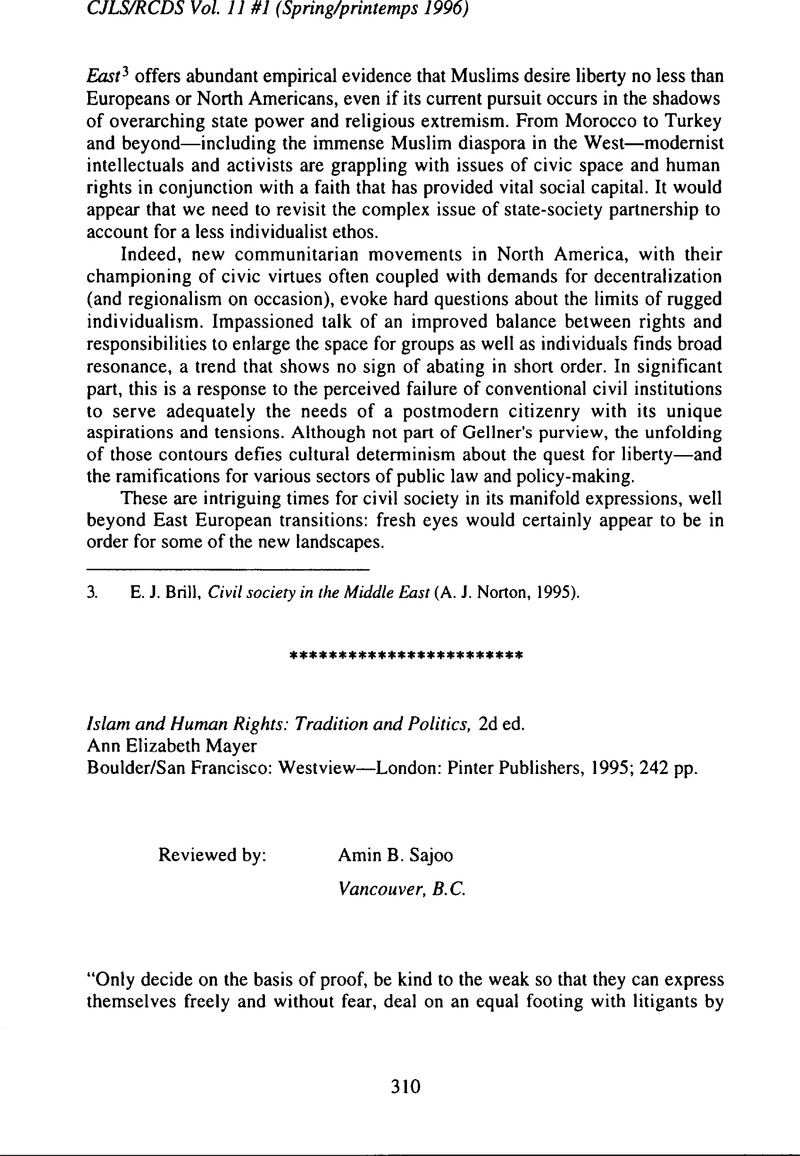No CrossRef data available.
Article contents
Islam and Human Rights: Tradition and Politics, 2d ed., Ann Elizabeth Mayer, Boulder/San Francisco: Westview—London: Pinter Publishers, 1995; 242 pp.
Published online by Cambridge University Press: 18 July 2014
Abstract

- Type
- Reviews/Recensions
- Information
- Canadian Journal of Law and Society / La Revue Canadienne Droit et Société , Volume 11 , Issue 1 , Spring/printemps 1996 , pp. 310 - 315
- Copyright
- Copyright © Canadian Law and Society Association 1996
References
1. Quoted in Broisard, Marcel A., “On the Probable Influence of Islam on Western Public and International Law,” (1980) 11 International Journal of Middle East Studies 429 at 440.CrossRefGoogle Scholar
2. “Islam and Toleration: Writers' Block” The Economist (27 January 1996) 78.
3. See, for example, Arzt, Donna, “The Application of Human Rights Law in Islamic States” (1990) 12 Human Rights Quarterly 218 CrossRefGoogle Scholar; Donnelly, Jack, “Human Rights and Human Dignity: An Analytic Critique of non-Western Conceptions of Human Rights” (1982) 76 American Political Science Review 303.CrossRefGoogle Scholar I have sketched the unfolding dialectic and some of its ramifications in the “Islamic Ethos and the
4. Gellner, Ernest, Conditions of Liberty: Civil Society and Its Rivals (London & Toronto: Hamish Hamilton/Penguin, 1994).Google Scholar
5. “Modern culture has developed conceptions of individualism which picture the human person as, at least potentially, finding his or her own bearings within, declaring independence from the webs of interlocution which have originally formed him/her … as though the dimension of interlocution were of significance only for the genesis of individuality … and play[s] no part in the finished person.” Taylor, Charles, Sources of the Self: The Making of the Modern Identity (Cambridge, MS: Harvard University Press, 1989) at 36.Google Scholar
6. See Banuazizi, Ali, “Faltering Legitimacy: The Ruling Clerics and Civil Society in Contemporary Iran,” (1995) 8 International Journal of Politics, Culture and Society 563.CrossRefGoogle Scholar
7. “The real source of [the militant group] Hamas's authority among Palestinians is not the mystique of the ‘armed struggle,’ but the broad range of social services it developed under Israeli occupation. Typically, a poor Palestinian family in the West Bank might send a child to a Hamas school on a Hamas bus, use a low-cost Hamas clinic … and, if really needy, get a ration of Hamas rice.” Schmemann, Serge, “Terror Isn't Alone as a Threat to Mideast Peace” The New York Times (3 March 1996) E1.Google Scholar
8. See Sajoo, Amin B., “Islam and Human Rights: Congruence or Dichotomy?” (1990) 4 Temple International & Comparative Law Journal 23 at 31–32.Google Scholar




